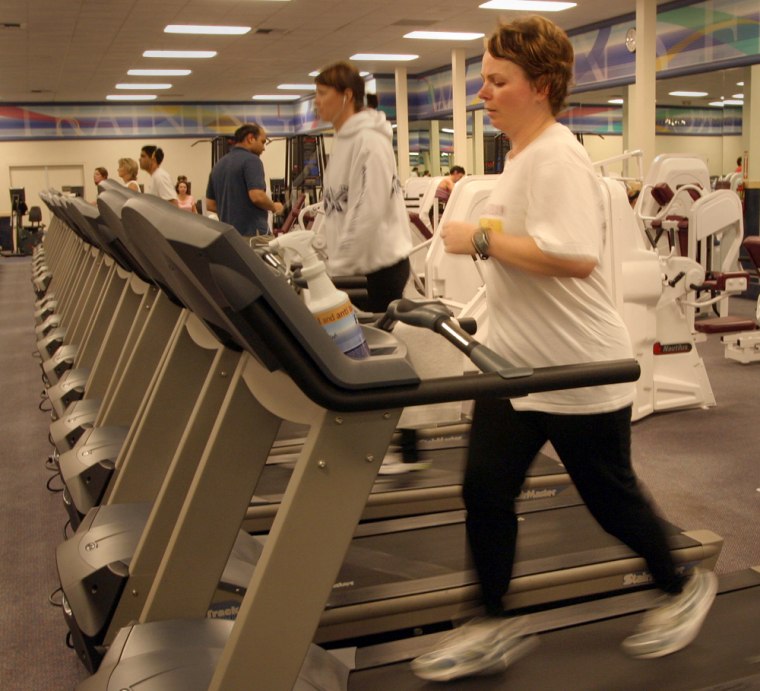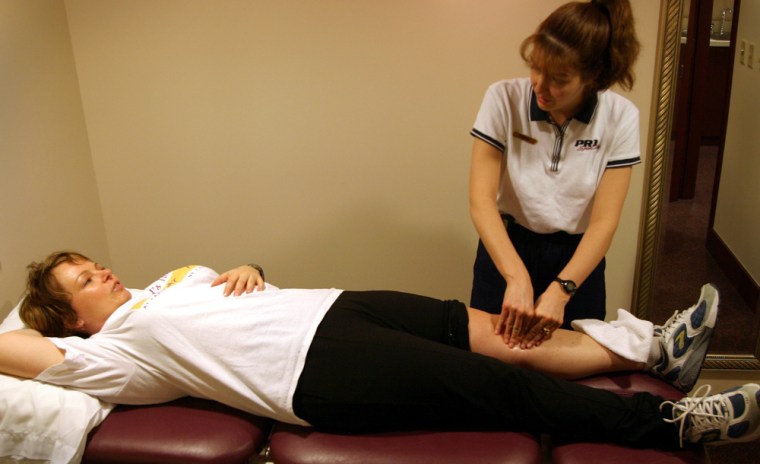This is not how I imagined I would open 2005 — in physical therapy. In my dreams, I was going to begin my Ironman year with a roar. Fresh on the heels of a strong finish in the Seattle half-marathon, I was going to hit the ground running — literally.
Unfortunately, that dream hit the ground with a thud during said half-marathon, when my left knee buckled out from underneath me at mile 9. After initial fears that I might have suffered a tear, the diagnosis was far more promising, and frustrating — patellar tendinitis. Promising because it meant no surgery. Frustrating because it meant a long, slow recovery.
But on the road to Ironman, there will be many frustrating moments. Just like there have been on the road to even thinking about taking the road to Ironman. And that’s where this journal comes in.
Everyone has a reason for beginning an exercise program, regardless of the scale or the goal. Mine began with a hike three years ago. I was 37 years old and had begun to see my backside expand after too many long days in front of a computer. My good friend wanted to go on a hike for her birthday — a moderate hike. No problem, I thought, I’m in pretty good shape despite my horizontal growth spurt. But that moderate hike — 4 miles uphill — reduced me to a panting, sweating, aching shell of my former self.
A couple of weeks after the hike, that same friend asked me if I wanted to try the Seattle half-marathon with her. After I stopped laughing and told her where she could put that suggestion, I gave it some thought. I had three months to get ready and having a goal at the end — a 13.1 mile race — might be the motivation I needed to really get into shape once and for all. I told her that I would give it a try. With the help of another friend, I found a training program on the Internet and started my journey into the world of long distance running. At the time, I couldn’t run a quarter mile much less a half-marathon.
Technique? There's technique involved?
I followed the plan and did my lonely training runs. My technique was horrible and my speed was nonexistent. But by race day, I had completed a 10 mile distance, with a mix of running and walking (okay, a lot of walking). I was nervous and apprehensive on race day, looking around at the hundreds of other competitors and wondering why I was there. “I’m not an athlete. I’m not in the same league as these people,” I thought. But when the race began, I took off with the rest of the runners. It didn’t take long for me to fade to the back of the pack, and in the end I walked about half of the distance, but I finished — in just over 3 hours.
The sense of accomplishment I felt after completing that race — and for the work I put into getting ready for it in the first place — fired my desire to continue training. And for the next year, I continued to work out on my own. I did two more half marathons and the Danskin women’s sprint triathlon. My times and results didn’t get much better, but I finished all of them.
As 2004 began, I thought that it was time to get some additional help. I joined the Seattle Triathlon club and through its message board, signed up for a class — swimming for endurance. The instructor was a personal trainer who has completed several Ironman triathlons. After finishing the five-hour course, I spoke with the instructor, Jeff, about training with him on a regular basis. I’ve been working with .
Over the spring and summer of 2004, I attended weekly track and triathlon workouts with a group of Jeff’s other clients, in addition to individual workouts (including riding my bike to work — 34 miles round trip — once a week) and began to see my running times get faster (from a 13 minute mile to a 9 ½ minute mile) and race results improve. I entered another half marathon and three sprint triathlons during the summer. And as I continued to workout, my weight began to drop and my loose and padded physique began to tighten and shrink. It was a gradual progression, but a progression none the less.
She's got a new attitude
But more than just my physical fitness improved — my entire mental outlook lightened. I no longer thought of myself as someone who didn’t belong at the race. I gradually realized that most of the other competitors weren’t super-jocks with model-perfect bodies. Most of them looked a great deal like me. Many of them were in their late 30s and well into their 50s. They all started the race with the same insecurities and fears. And they all finished with the same sense of accomplishment.

In addition to a greater feeling of confidence and self-worth, my concentration improved. My attitude about my job and my life improved and I started to believe that I was capable of accomplishing bigger, more difficult goals.
And that’s where Ironman comes in. A good friend of mine, Juliet, spent most of the past year training for her first Ironman event. Initially, I marveled at her dedication and skill. “She’s in a whole different league than me,” I thought in early summer. But as I got deeper into my training season, and saw how much stronger she was getting, I began to realize that she wasn’t that different from me. Just a little further down the line. And while she is a very special person, she isn’t a super athletic person. Just someone who decided to do something, put in the work and followed through on it.
'Catching' the Iron bug
To show my solidarity for Juliet’s efforts, I went to the race — Ironman Canada — to cheer her on and to be there to share the culmination of her dream. I volunteered to work the finish line as a catcher (because in some cases, you literally “catch” the staggering competitors as they finish the grueling test of endurance). And I did catch a few, some in pain, dehydrated and exhausted. But most were exhilarated and just plain tired — just like Juliet who completed the race in 13 hours, 59 minutes. They were radiant and thrilled — they were Ironmen! The very next morning, with heart in throat and my pulse racing, I signed up for the 2005 race.
In the weeks since then, I have had many, many moments of doubt, most definitely when my knee went out from under me during the half marathon in November. I questioned my ability and my judgment. And I will continue to do so in the months ahead. But I also have had many moments when I’ve imagined the joy of finishing, and been bolstered by the confidence and enthusiasm of my trainer, Jeff, and my friends and family.
In the months ahead, I will record all of the ups and downs, the doubts and the exhilarating expectations. Along the way, I hope to offer some tips on picking a coach, choosing an event, sticking with a training plan and a goal. Not everyone is cut out to be an Ironman. But everybody can get off the couch and start chasing a dream. I hope you will join me on the voyage.
